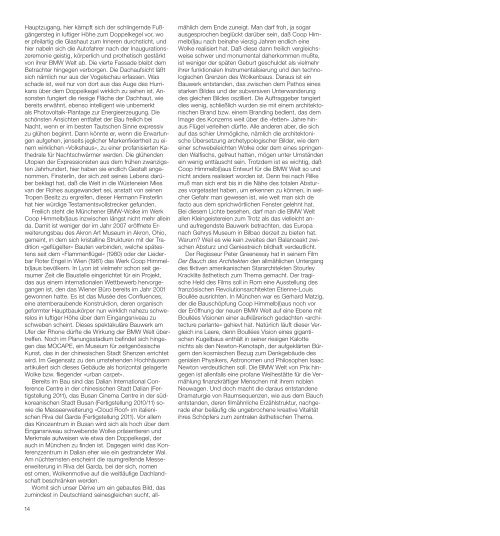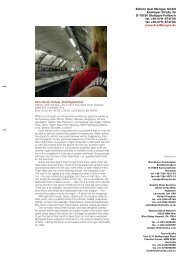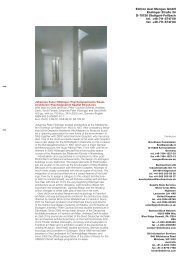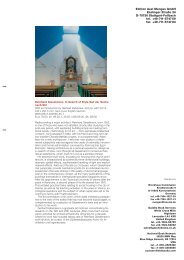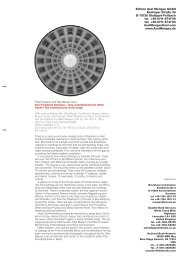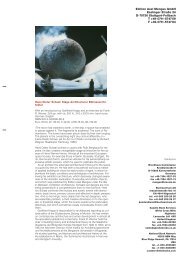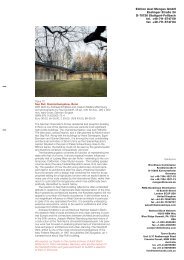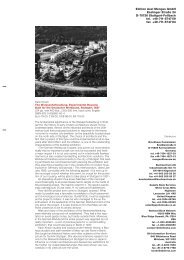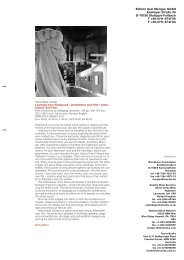Opus 54. Eiermann, Wash, d - Edition Axel Menges
Opus 54. Eiermann, Wash, d - Edition Axel Menges
Opus 54. Eiermann, Wash, d - Edition Axel Menges
Erfolgreiche ePaper selbst erstellen
Machen Sie aus Ihren PDF Publikationen ein blätterbares Flipbook mit unserer einzigartigen Google optimierten e-Paper Software.
Hauptzugang, hier kämpft sich der schlingernde Fußgängersteg<br />
in luftiger Höhe zum Doppelkegel vor, wo<br />
er pfeilartig die Glashaut zum Inneren durchsticht, und<br />
hier nabeln sich die Autofahrer nach der Inaugurationszeremonie<br />
geistig, körperlich und prothetisch gestärkt<br />
von ihrer BMW Welt ab. Die vierte Fassade bleibt dem<br />
Betrachter hingegen verborgen. Die Dachaufsicht läßt<br />
sich nämlich nur aus der Vogelschau erfassen. Was<br />
schade ist, weil nur von dort aus das Auge des Hurrikans<br />
über dem Doppelkegel wirklich zu sehen ist. Ansonsten<br />
fungiert die riesige Fläche der Dachhaut, wie<br />
bereits erwähnt, ebenso intelligent wie unbemerkt<br />
als Photovoltaik-Plantage zur Energieerzeugung. Die<br />
schönsten Ansichten entfaltet der Bau freilich bei<br />
Nacht, wenn er im besten Tautschen Sinne expressiv<br />
zu glühen beginnt. Dann könnte er, wenn die Erwartungen<br />
aufgehen, jenseits jeglicher Markenfixiertheit zu einem<br />
wirklichen »Volkshaus«, zu einer profanisierten Kathedrale<br />
für Nachtschwärmer werden. Die glühenden<br />
Utopien der Expressionisten aus dem frühen zwanzigsten<br />
Jahrhundert, hier haben sie endlich Gestalt angenommen.<br />
Finsterlin, der sich zeit seines Lebens darüber<br />
beklagt hat, daß die Welt in die Wüsteneien Mies<br />
van der Rohes ausgewandert sei, anstatt von seinen<br />
Tropen Besitz zu ergreifen, dieser Hermann Finsterlin<br />
hat hier würdige Testamentsvollstrecker gefunden.<br />
Freilich steht die Münchener BMW-Wolke im Werk<br />
Coop Himmelb(l)aus inzwischen längst nicht mehr allein<br />
da. Damit ist weniger der im Jahr 2007 eröffnete Erweiterungsbau<br />
des Akron Art Museum in Akron, Ohio,<br />
gemeint, in dem sich kristalline Strukturen mit der Tradition<br />
»geflügelter« Bauten verbinden, welche spätestens<br />
seit dem »Flammenflügel« (1980) oder der Liederbar<br />
Roter Engel in Wien (1981) das Werk Coop Himmelb(l)aus<br />
bevölkern. In Lyon ist vielmehr schon seit geraumer<br />
Zeit die Baustelle eingerichtet für ein Projekt,<br />
das aus einem internationalen Wettbewerb hervorgegangen<br />
ist, den das Wiener Büro bereits im Jahr 2001<br />
gewonnen hatte. Es ist das Musée des Confluences,<br />
eine atemberaubende Konstruktion, deren organisch<br />
geformter Hauptbaukörper nun wirklich nahezu schwerelos<br />
in luftiger Höhe über dem Eingangsniveau zu<br />
schweben scheint. Dieses spektakuläre Bauwerk am<br />
Ufer der Rhone dürfte die Wirkung der BMW Welt übertreffen.<br />
Noch im Planungsstadium befindet sich hingegen<br />
das MOCAPE, ein Museum für zeitgenössische<br />
Kunst, das in der chinesischen Stadt Shenzen errichtet<br />
wird. Im Gegensatz zu den umstehenden Hochhäusern<br />
artikuliert sich dieses Gebäude als horizontal gelagerte<br />
Wolke bzw. fliegender »urban carpet«.<br />
Bereits im Bau sind das Dalian International Conference<br />
Centre in der chinesischen Stadt Dalian (Fertigstellung<br />
2011), das Busan Cinema Centre in der südkoreanischen<br />
Stadt Busan (Fertigstellung 2010/11) sowie<br />
die Messeerweiterung »Cloud Roof« im italienischen<br />
Riva del Garda (Fertigstellung 2011). Vor allem<br />
das Kinozentrum in Busan wird sich als hoch über dem<br />
Eingansniveau schwebende Wolke präsentieren und<br />
Merkmale aufweisen wie etwa den Doppelkegel, der<br />
auch in München zu finden ist. Dagegen wirkt das Konferenzzentrum<br />
in Dalian eher wie ein gestrandeter Wal.<br />
Am nüchternsten erscheint die raumgreifende Messeerweiterung<br />
in Riva del Garda, bei der sich, nomen<br />
est omen, Wolkenmotive auf die weitläufige Dachlandschaft<br />
beschränken werden.<br />
Womit sich unser Dérive um ein gebautes Bild, das<br />
zumindest in Deutschland seinesgleichen sucht, all-<br />
mählich dem Ende zuneigt. Man darf froh, ja sogar<br />
ausgesprochen beglückt darüber sein, daß Coop Himmelb(l)au<br />
nach beinahe vierzig Jahren endlich eine<br />
Wolke realisiert hat. Daß diese dann freilich vergleichsweise<br />
schwer und monumental daherkommen mußte,<br />
ist weniger der späten Geburt geschuldet als vielmehr<br />
ihrer funktionalen Instrumentalisierung und den technologischen<br />
Grenzen des Wolkenbaus. Daraus ist ein<br />
Bauwerk entstanden, das zwischen dem Pathos eines<br />
starken Bildes und der subversiven Unterwanderung<br />
des gleichen Bildes oszilliert. Die Auftraggeber tangiert<br />
dies wenig, schließlich wurden sie mit einem architektonischen<br />
Brand bzw. einem Branding bedient, das dem<br />
Image des Konzerns weit über die »fetten« Jahre hinaus<br />
Flügel verleihen dürfte. Alle anderen aber, die sich<br />
auf das schier Unmögliche, nämlich die architektonische<br />
Übersetzung archetypologischer Bilder, wie dem<br />
einer schwebeleichten Wolke oder dem eines springenden<br />
Walfischs, gefreut hatten, mögen unter Umständen<br />
ein wenig enttäuscht sein. Trotzdem ist es wichtig, daß<br />
Coop Himmelb(l)aus Entwurf für die BMW Welt so und<br />
nicht anders realisiert worden ist. Denn frei nach Rilke<br />
muß man sich erst bis in die Nähe des totalen Absturzes<br />
vorgetastet haben, um erkennen zu können, in welcher<br />
Gefahr man gewesen ist, wie weit man sich de<br />
facto aus dem sprichwörtlichen Fenster gelehnt hat.<br />
Bei diesem Lichte besehen, darf man die BMW Welt<br />
allen Kleingeistereien zum Trotz als das vielleicht anund<br />
aufregendste Bauwerk betrachten, das Europa<br />
nach Gehrys Museum in Bilbao derzeit zu bieten hat.<br />
Warum? Weil es wie kein zweites den Balanceakt zwischen<br />
Absturz und Geniestreich bildhaft verdeutlicht.<br />
Der Regisseur Peter Greeneway hat in seinem Film<br />
Der Bauch des Architekten den allmählichen Untergang<br />
des fiktiven amerikanischen Stararchitekten Stourley<br />
Kracklite ästhetisch zum Thema gemacht. Der tragische<br />
Held des Films soll in Rom eine Ausstellung des<br />
französischen Revolutionsarchitekten Étienne-Louis<br />
Boullée ausrichten. In München war es Gerhard Matzig,<br />
der die Bauschöpfung Coop Himmelb(l)aus noch vor<br />
der Eröffnung der neuen BMW Welt auf eine Ebene mit<br />
Boullées Visionen einer aufklärerisch gedachten »architecture<br />
parlante« gehievt hat. Natürlich läuft dieser Vergleich<br />
ins Leere, denn Boullées Vision eines gigantischen<br />
Kugelbaus enthält in seiner riesigen Kalotte<br />
nichts als den Newton-Kenotaph, der aufgeklärten Bürgern<br />
den kosmischen Bezug zum Denkgebäude des<br />
genialen Physikers, Astronomen und Philosophen Isaac<br />
Newton verdeutlichen soll. Die BMW Welt von Prix hingegen<br />
ist allenfalls eine profane Weihestätte für die Vermählung<br />
finanzkräftiger Menschen mit ihrem noblen<br />
Neuwagen. Und doch macht die daraus entstandene<br />
Dramaturgie von Raumsequenzen, wie aus dem Bauch<br />
entstanden, deren filmähnliche Erzählstruktur, nachgerade<br />
eher beiläufig die ungebrochene kreative Vitalität<br />
ihres Schöpfers zum zentralen ästhetischen Thema.<br />
7. Etienne-Louis Boullée, Kenotaph für Newton, 1784.<br />
7. Etienne-Louis Boullée, cenotaph for Newton, 1784.<br />
The north-east view is articulated entirely differently.<br />
The fact is that the large joint that Prix has incised here<br />
on the Lerchenauer Strasse side in order to bring daylight<br />
into the hall and to pay tribute at least visually to<br />
Schwanzer’s »Four Cylinders« breaks up the compelling<br />
roof structure of the cloud backdrop. Its right-hand, inflated<br />
part seems to break off. And yet for the company<br />
this is the most important side of the new building.<br />
When all is said and done, this is where the main entrance<br />
is, here the pedestrian walkway weaves its lofty<br />
way towards the double cone then breaks through into<br />
the interior like an arrow, and here the car drivers cut<br />
the umbilical cord from their BMW Welt after the inauguration<br />
ceremony, strengthened spiritually, physically<br />
and prosthetically. But the fourth façade remains hidden<br />
to viewers. The roof view can be seen only from above.<br />
Which is a pity, because it is only here that the eye of<br />
the hurricane above the double cone can be seen. Otherwise<br />
the gigantic surface of the roof, as has already<br />
been mentioned, functions as intelligently as inconspicuously<br />
as a photovoltaic plantation for generating energy.<br />
Admittedly the building looks at its most beautiful<br />
at night, when it starts to glow expressively in the best<br />
Tautian sense. Then it could, if expectations are fulfilled,<br />
become a real »people’s palace«, a secularized cathedral<br />
for night-lovers, well beyond any brand obsession.<br />
The glowing Utopias of the Expressionists in the early<br />
twentieth century have finally been realized here. Finsterlin,<br />
who complained in his lifetime that the world had<br />
emigrated into Mies van der Rohe’s wildernesses, rather<br />
than seizing possession of his tropics, has found worthy<br />
executors for his will here.<br />
Admittedly the Munich BMW cloud is no longer a<br />
solitaire in Coop Himmelb(l)au’s œuvre. Here I am not<br />
really referring to the extension for the Akron Art Museum<br />
in Akron, Ohio, which opened in 2007, where crystalline<br />
structures are combined with the tradition of<br />
»winged« buildings that have featured in Coop Himmelb(l)au’s<br />
work at the latest since the »Flammenflügel«<br />
(1980) or the Roter Engel bar in Vienna (1981). A building<br />
site has been ready in Lyon for a great deal of time now<br />
for a project emerging from an international competition<br />
that the Vienna practice won as early as 2001. This is<br />
the Musée des Confluences, a breathtaking structure<br />
whose organically shaped main building really seems<br />
to float almost weightlessly in the airy heights above the<br />
entrance level. This spectacular building on the bank of<br />
the Rhone must make a greater impact than the BMW<br />
Welt. But the MOCAPE, a museum of contemporary art<br />
that is to be built in the Chinese city of Shenzen is still<br />
at the planning stage. In contrast with the skyscrapers<br />
surrounding it, this building is articulated as a horizontally<br />
bedded cloud or a flying »urban carpet«.<br />
The Dalian International Conference Centre in the<br />
Chinese city of Dalian (completion in 2011), the Busan<br />
cinema centre in the South Korean city of Busan (completion<br />
2010/11) and the »Cloud Roof« exhibition centre<br />
extension in Riva del Garda in Italy (completion 2011)<br />
are already under construction. The cinema centre in<br />
Busan in particular will present itself as a cloud floating<br />
above the entrance level and have characteristics like<br />
the double cone, for example, that is also to be found in<br />
Munich. The Dalian Conference Centre, however, looks<br />
more like a beached whale. The most austere-looking<br />
of all is the exhibition centre extension in Riva del Garda,<br />
where, nomen est omen, cloud motifs will be restricted<br />
to the extensive roofscape.<br />
Which brings our drift around a built image that is<br />
unequalled in Germany at least almost to an end. We<br />
should be pleased, indeed positively delighted, that<br />
Coop Himmelb(l)au have at last realized a cloud after almost<br />
forty years. The fact that this had to turn out comparatively<br />
heavy and monumental is due less to the late<br />
birth than to the functional instrumentalization of the<br />
building and the technological restrictions placed on the<br />
cloud structure. This has all led to a building oscillating<br />
between the emotional drama of a powerful image and<br />
the subversive undermining of that same image. This<br />
makes little impact on the clients, ultimately they have<br />
been served with an architectural brand or branding<br />
that should lend wings to the company image well beyond<br />
the »fat« years. But everyone else who had been<br />
looking forward to the well-nigh impossible, to seeing<br />
the architectural implementation of archetypological images<br />
like that of a floating cloud or a leaping whale may<br />
well be just a little disappointed. Nevertheless it is important<br />
that Coop Himmelb(l)au’s design for the BMW<br />
Welt was realized like this and not otherwise: to cite<br />
Rilke loosely, it is necessary first to feel one’s way to the<br />
brink of total collapse in order to be able to realize in<br />
what danger one was, how far one had in fact leaned<br />
out of the proverbial window. Seen in this light, despite<br />
all the mean-spiritedness, it is right to see the BMW<br />
Welt as what is perhaps the most stimulating and exciting<br />
building that Europe has to offer at present after<br />
Gehry’s museum in Bilbao. Why? Because like no other<br />
it vividly illustrates the balancing act between collapse<br />
and a stroke of genius.<br />
In his film Belly of an Architect, director Peter Greenaway<br />
addressed aesthetically the subject of the gradual<br />
decline of the fictitious American star architect Stourley<br />
Kracklite. The film’s tragic hero is supposed to be setting<br />
up an exhibition about the French revolutionary architect<br />
Étienne-Louis Boullée in Rome. In Munich it was<br />
Gerhard Matzig who hoisted Coop Himmelb(l)au’s architectural<br />
creation onto the plane of Boullée’s vision of<br />
»architecture parlante«, even before the BMW Welt<br />
opened. Of course this comparison doesn’t work, as<br />
Boullée’s vision of a gigantic spherical building contains<br />
nothing in its enormous flattened dome but the Newton<br />
cenotaph, intended to show enlightened citizens a cosmic<br />
link with the intellectual edifice constructed by the<br />
brilliant physicist, astronomer and philosopher Isaac<br />
Newton. But Prix’s BMW Welt is at best a secular shrine<br />
for the marriage of wealthy people to their classy new<br />
cars. And yet the drama of spatial sequences this has<br />
produced, as if from the belly, their film-like narrative<br />
structure, almost casually makes their creator’s unbroken<br />
creative vitality into the central aesthetic theme.<br />
14 15


